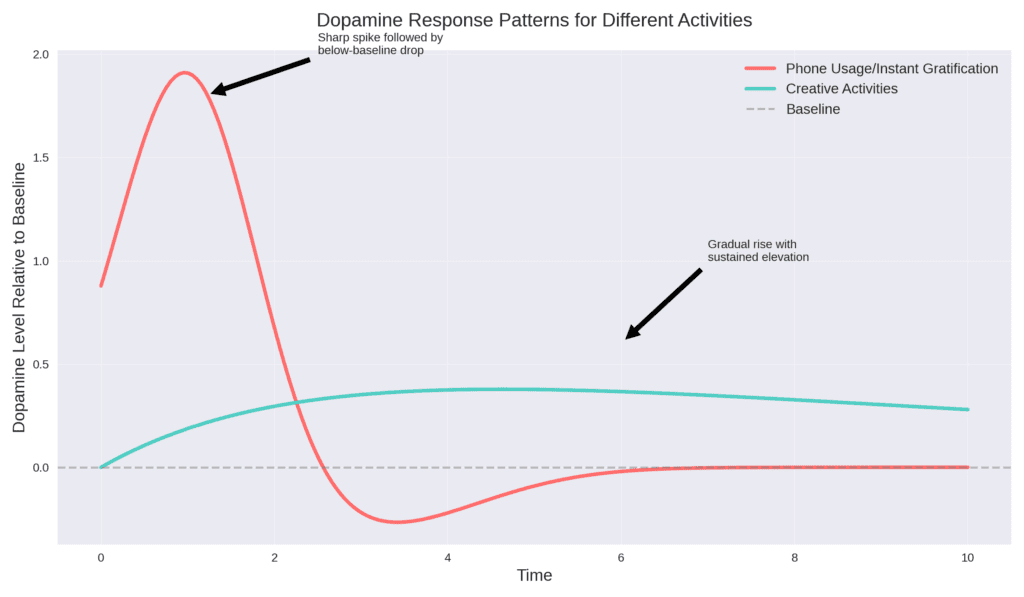Today’s kids are growing up surrounded by screens, constant notifications, and endless scrolling. Social media and games are built to grab their attention by delivering quick dopamine hits—the chemical that makes us feel good. These short bursts may feel exciting in the moment, but they often leave kids (and adults) feeling drained, distracted, and less motivated over time.
So, how can we help kids find balance and discover healthier ways to feel good? Let’s break down what dopamine is, how screens affect young minds, and small changes that can make a big difference.

The Dopamine Cycle
Dopamine is a chemical in the brain that plays a key role in focus, motivation, and reward. But not all dopamine works the same way.
Quick dopamine comes from activities like swiping on social media, binge-watching videos, or playing addictive games. These activities offer instant gratification but lead to a crash. Kids often end up feeling restless or irritable.
Slow dopamine comes from meaningful activities like drawing, playing outside, reading, or solving puzzles. It’s released gradually, creating a steady sense of accomplishment and long-term happiness.
Think of it like this: fast dopamine gives you a sugar rush, while slow dopamine feels more like a nourishing meal. The first is tempting but fleeting, while the second gives lasting value.

Why Screens Keep Us Hooked
Tech companies spend a fortune studying human behavior to make their apps nearly impossible to ignore. Algorithms are designed to give us an endless supply of content tailored to our interests. This keeps people scrolling far longer than they planned.
Why does this happen? Because our brains crave novelty, and screens are perfect at delivering it. One video leads to another, one post to the next, until hours have passed.
How Social Media Impacts Kids
The dopamine roller coaster isn’t the only issue. Constant screen time also affects kids in other ways:
- More Stress: Frequent notifications and multitasking increase cortisol, the hormone linked to stress.
- Shorter Attention Spans: Overstimulation makes it harder for kids to focus on reading, homework, or other tasks.
- Self-Esteem Issues: Social media creates opportunities for comparison. Kids often feel inadequate when they see unrealistic images or lifestyles online.
What Can We Do?
The goal isn’t to ban screens but to help kids understand that some activities feel good now but leave them empty later, while others build joy and confidence that lasts.
The good news is there are simple ways to help kids step back from screens and reconnect with real life.
Simple Ways to Help Kids Take a Break from Screens
- Create Screen-Free Zones:Keep bedrooms and dining areas screen-free. Encourage kids to swap video games for outdoor play
- Try Digital Fasting: Start with one evening a week without screens. Fill the time with board games, yoga, or family fun
- Go Phone-Free in the Mornings: Help kids start their day calmly. Suggest chantings, yoga, light stretches, reading, or a short walk instead of screens.
- Make Time for Nature: Take kids to a park, on hikes, for picnics, or plant flowers together—fresh air naturally soothes the mind. The body is made up of five elements: earth, water, fire, air, and sky. Encourage them to connect with these elements daily for a balanced and healthy life.
Small Steps Toward a Healthier Mind
Social media isn’t the enemy, but it can take a toll on kids when it dominates their time. It’s easy for them to get caught up in scrolling, comparing, and feeling disconnected from their own emotions. That’s when activities, like yoga, sports or art, can make a real difference.
Yoga offers kids a gentle way to pause, breathe, and feel grounded. It’s not about performance or competition; it’s about learning to listen to their bodies and minds. Over time, it can help them build habits that promote focus, patience, and emotional balance.
Yoga along with other activities like sports, art or craft not only help reduce anxiety and stress but also create a foundation for healthier coping skills.
In a world full of distractions, offering kids the tools to unwind and recharge is a gift they’ll carry for years. Whether it’s finding calm after a busy day or building confidence in their ability to manage emotions.
Give your child the chance to step away from constant noise and discover the power of stillness. Let them reconnect with themselves in a way that feels natural and fun.





It’s a great post it really reminded me of keeping my electronic gadgets away keep reminding us by making educational and health related post
This can be more fun with pictures I hope it will make a little attractive and kids would like to learn and explore more ☺️ but it was also good
I liked the way how you explained in detail